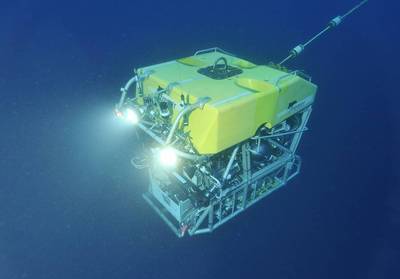French Send Deep Diving Robot to Help Titanic Sub Search
A French robot that can dive to 20,000 feet (6,000 meters) underwater is on its way to help find a tourist submersible that vanished as it descended to the Titanic wreck and it could help free the sub if it is trapped, its operator said on Wednesday.
The unmanned robot, called Victor 6000, can dive deeper than other equipment now at the site in the North Atlantic and has arms that can be remotely controlled to cut cables or perform other maneuvers to release a stuck vessel, the operator said.
The robot, which is aboard a French research vessel, is expected to arrive late on Wednesday, giving it a limited window to provide assistance before the Thursday morning deadline when the missing submersible's air supply is expected to run out.
"Victor is not capable of lifting the submarine up on its own," said Olivier Lefort, the head of naval operations at Ifremer, the state-run French ocean research institute which operates the robot.
But he told Reuters the robot could help hook the 10-tonne submersible called Titan to a ship with the capacity to lift it to the surface.
Titan went missing with five people on board shortly after starting its descent on Sunday to the Titanic, the British ocean liner that sank in 1912 after hitting an iceberg. The wreck lies at a depth of about 12,500 feet (3,810 meters).
"Victor is able to do visual exploration with all the video equipment it has. It is also equipped with manipulating arms which could be used to extricate the sub, such as by sectioning cables or things that would be blocking it at the bottom," he said.
Ifremer was part of the team that located the wreck of the Titanic in 1985 with American underwater archaeologist Robert Ballard.
French explorer Paul-Henri Nargeolet, 77, who is reported to be among the five people inside the missing submersible, previously worked at Ifremer and piloted its flagship Nautile submarine that was used to examine the Titanic wreck.
Ifremer sent the Atalante ship with its robot at the request of the U.S. Navy. "This is the logic of seafarers. Our attitude was: We are close, we have to go," Lefort said.
The robot is operated by a 25-strong crew. "We can work non-stop for up to 72 hours, we don't need to stop at night," he said.
The U.S. Coast Guard said Canadian aircraft equipped to find submarines had detected noises in the area. U.S. media reported that those sounds included banging at 30-minute intervals.
"We don't know what happened. The noises that were heard give us hope the submarine is on the seabed and that people are still alive, but other scenarios are possible," Lefort said. "Even if hope is slim, we'll go all the way."
(Reuters - Writing by Michel Rose; Editing by Edmund Blair)












